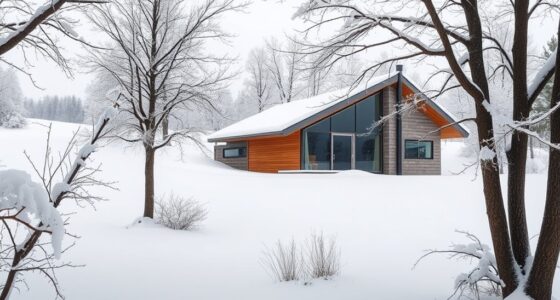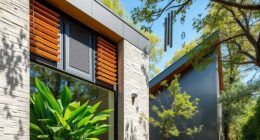The Alaska Overland Truck Cabin provides a unique and exciting way to explore the rugged and isolated terrain of Alaska. Built on a 1996 Ford F350 with a Powerstroke Diesel 7.3 engine and a 6-inch lift kit, this cabin is designed to withstand Alaska’s harsh weather conditions and extreme outdoor adventures.
The cabin is made of wood and varnished to be waterproof, with double sealed windows and a 5/12 pitch roof that sheds water and snow instantly. One of the most unique features of the Alaska Overland Truck Cabin is its chimney, which allows for a fire while driving.
This feature is perfect for those cold Alaskan nights and adds to the overall cozy and rustic feel of the cabin. The Truck House Life (formerly Full Send Alaskan Overland) YouTube channel documents the journey of living life on the road in this adventurous cabin. From how-to instructions to product reviews, the channel shares their passion for adventuring, sharing, and inspiring others to explore the world around them.
Key Takeaways
- The Alaska Overland Truck Cabin is built on a 1996 Ford F350 and is designed to withstand extreme outdoor sports and harsh weather conditions of Alaska.
- Living in a truck cabin requires a certain level of adaptability and creativity, as well as simplifying belongings, planning ahead, and staying organized to maximize living space.
- The cabin is sustainable and eco-friendly, with a solar panel installed for power and propane cooktop and oven for cooking.
- The vanlife community is a growing movement of people who have chosen to live a life on the road, and living life on the road can be a fulfilling and rewarding experience for those who are adaptable and flexible.
Truck Cabin Build
The build of the Alaska overland truck cabin is described as a unique and durable home on wheels. The cabin was built using a 1996 Ford F350 with Powerstroke Diesel 7.3 and 6-inch lift, allowing for off-road challenges and long-term maintenance.
The construction involves wood, which was treated with varnish to make it waterproof, and double sealed windows to ensure insulation and protection from harsh weather conditions. DIY techniques and woodworking skills were employed to create a unique chimney that allows for a fire while driving, and a 5/12 pitch roof that sheds water and snow instantly.
To ensure durability, the cabin was over-engineered to withstand vibration and potholes, and a solar panel was installed for power. Off-road challenges and maintenance tips are also shared, making the build of the Alaska overland truck cabin not only a unique and comfortable home on wheels but also a learning experience for those who aspire to embark on similar adventures.
Features and Amenities
Featuring a propane cooktop and oven with a fan above, fold-out workspaces, and a 6-person sofa that converts into two beds, the Alaska overland truck cabin offers a comfortable and functional living space for those with a passion for adventure on the road.
The cabin is equipped with all the necessary amenities for campsite cooking, including a propane cooktop and oven, as well as a fan above to keep the air circulating.
The fold-out workspaces in the kitchen provide ample room for meal preparation, while the 6-person sofa can be easily converted into two beds for a good night’s sleep.
In addition to its comfortable living space, the Alaska overland truck cabin is also designed for off-grid power.
The cabin is equipped with a solar panel for power, allowing for a sustainable and eco-friendly way to power the cabin’s amenities.
This feature is especially useful for those who enjoy remote camping and off-grid living, as it allows for a reliable source of power without the need for a generator or other external power source.
Overall, the Alaska overland truck cabin offers a unique and functional living space for those with a passion for adventure on the road, with features and amenities designed to make life on the road comfortable and convenient.
Living Life on the Road
For those who choose to live a nomadic lifestyle, adapting to life on the road can be a challenging yet rewarding experience. Living in a truck cabin like the Alaska Overland Truck Cabin requires a certain level of adaptability and creativity. The vanlife community is a growing movement of people who have chosen to live a life on the road, and they have come up with creative solutions to make their mobile homes comfortable and functional.
Here are some tips for living life on the road:
-
Simplify your belongings: Living in a small space requires you to be selective with what you bring with you.
-
Plan ahead: Knowing where you will be staying and what amenities are available can make your life on the road easier.
-
Stay organized: Keep your living space tidy and organized to maximize your living space.
-
Stay flexible: Being adaptable is key to living life on the road. Unexpected situations can arise, and being able to pivot your plans can make all the difference in your experience as a nomad.
Living life on the road is not for everyone, but for those who choose to embrace the nomadic lifestyle, it can be a fulfilling and rewarding experience. The vanlife community has created a network of people who support and encourage each other in their pursuit of adventure on wheels. With determination and creativity, anyone can make a mobile home that is both comfortable and functional.
Frequently Asked Questions
How did the author finance the building of the Alaska overland truck cabin?
The author of the Alaska Overland Truck Cabin did not provide specific information regarding how he financed the building of the cabin. However, based on the information presented in his YouTube channel and website, it is possible that he used a combination of personal savings and crowdfunding.
The author has mentioned in his videos that he is a carpenter and has experience in building and renovating houses. This suggests that he may have been able to save money by doing most of the construction work himself.
Additionally, the author has mentioned that he received sponsorship from companies that provided materials for the cabin. This suggests that he may have used crowdfunding platforms to raise funds for the project.
Regardless of the financing method, the author’s emphasis on durability and over-engineering suggests that he was committed to investing in a high-quality, long-lasting product.
What kind of permits are required to live in a truck house in Alaska?
Navigating the complex web of permit requirements and zoning regulations in Alaska can be a daunting task for those seeking to live in a truck house.
In order to legally reside in one, individuals must first obtain a permit from the Alaska Department of Transportation and Public Facilities, which oversees the state’s highway and road systems.
Additionally, there may be zoning regulations that vary depending on the specific location and municipality. These regulations may dictate where a truck house can be parked and for how long, and may also require certain safety standards to be met.
It is important for those interested in living in a truck house in Alaska to thoroughly research and understand the necessary permit requirements and zoning regulations before embarking on this unique lifestyle.
How does the author maintain the wood exterior of the truck cabin in extreme weather conditions?
Maintaining the wood exterior of a truck cabin in extreme weather conditions requires protective coatings and ensuring durability. Wood is susceptible to damage from moisture, UV rays, and temperature fluctuations.
To prevent these issues, the author of the Alaska Overland Truck Cabin utilized varnish to waterproof the wood exterior, similar to how boats are protected. Additionally, the double-sealed windows and metal roof with a membrane layer of water and ice shield provide further protection against harsh weather conditions.
The author also over-engineered the cabin for durability to withstand vibration and potholes. By taking these measures, the wood exterior of the truck cabin can be maintained and protected from the elements, ensuring a comfortable and safe living space while adventuring on the road.
What challenges did the author face while living on the road in Alaska and how did they overcome them?
Living off grid and surviving in the wilderness can be an arduous and challenging experience. The author of the Alaska Overland Truck Cabin faced various challenges during their time on the road in Alaska.
Extreme weather conditions, such as heavy snowfall and freezing temperatures, made it difficult to keep the cabin warm and dry. In addition, navigating through remote places with limited access to resources and services was a constant struggle.
However, the author overcame these challenges by adopting a resilient and resourceful mindset. They utilized the cabin’s unique features, such as the double sealed windows and chimney, to stay warm and cook meals. Moreover, they relied on their skills and creativity to find solutions to unexpected problems.
Overall, the author’s experience of living off grid and surviving in the wilderness exemplifies the importance of adaptability and perseverance in extreme conditions.
Does the author have any tips for staying connected to the outside world while living in remote areas?
In our modern world, staying connected to the outside world is an essential part of our daily lives. However, for those living in remote areas, it can be a challenge to maintain the same level of connectivity.
Fortunately, the author of this article has some tips for staying connected while living off the grid. For starters, investing in a reliable satellite phone or two-way radio is key for emergency situations.
Additionally, utilizing solar panels for power and investing in a high-quality internet service provider can make all the difference. Finding creative ways to stay connected, such as using a mobile hotspot or setting up a community network with fellow remote dwellers, can also be helpful.
Ultimately, with determination and resourcefulness, staying connected while living in remote areas is achievable.
I’m Theodore, and I love tiny houses. In fact, I’m the author of Tiny House 43, a book about tiny houses that are also tree houses. I think they’re magical places where imaginations can run wild and adventures are just waiting to happen.
While tree houses are often associated with childhood, they can be the perfect adult retreat. They offer a cozy space to relax and unwind, surrounded by nature. And since they’re typically built on stilts or raised platforms, they offer stunning views that traditional homes simply can’t match.
If you’re looking for a unique and romantic getaway, a tree house tiny house might just be the perfect option.










